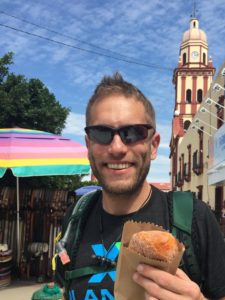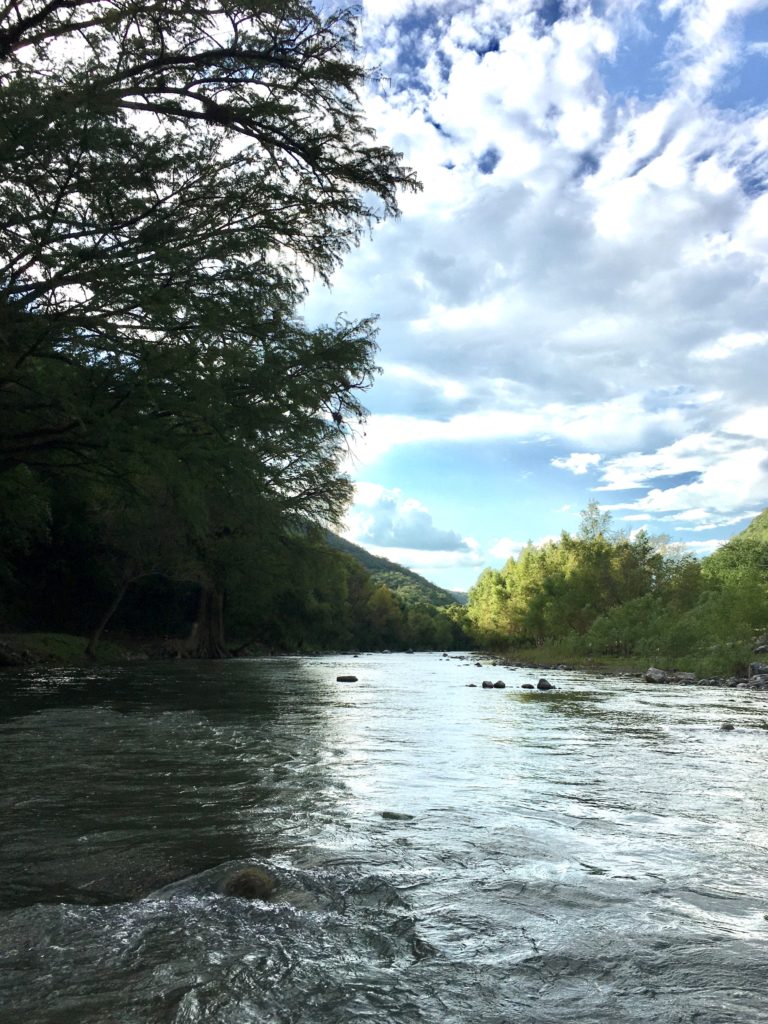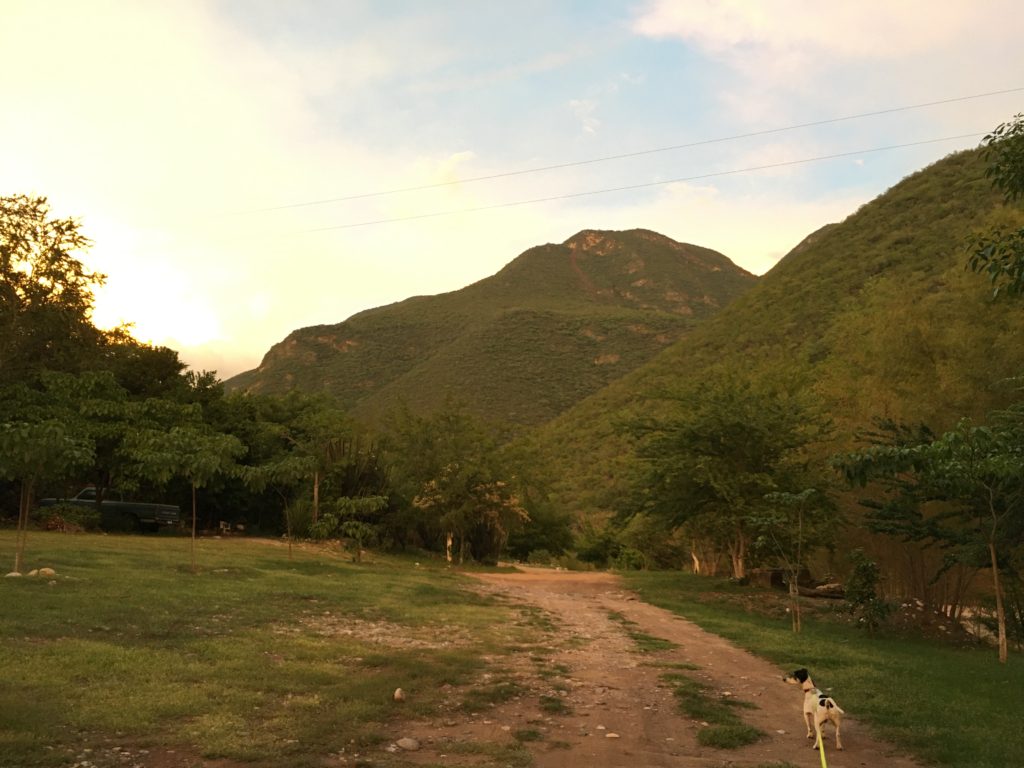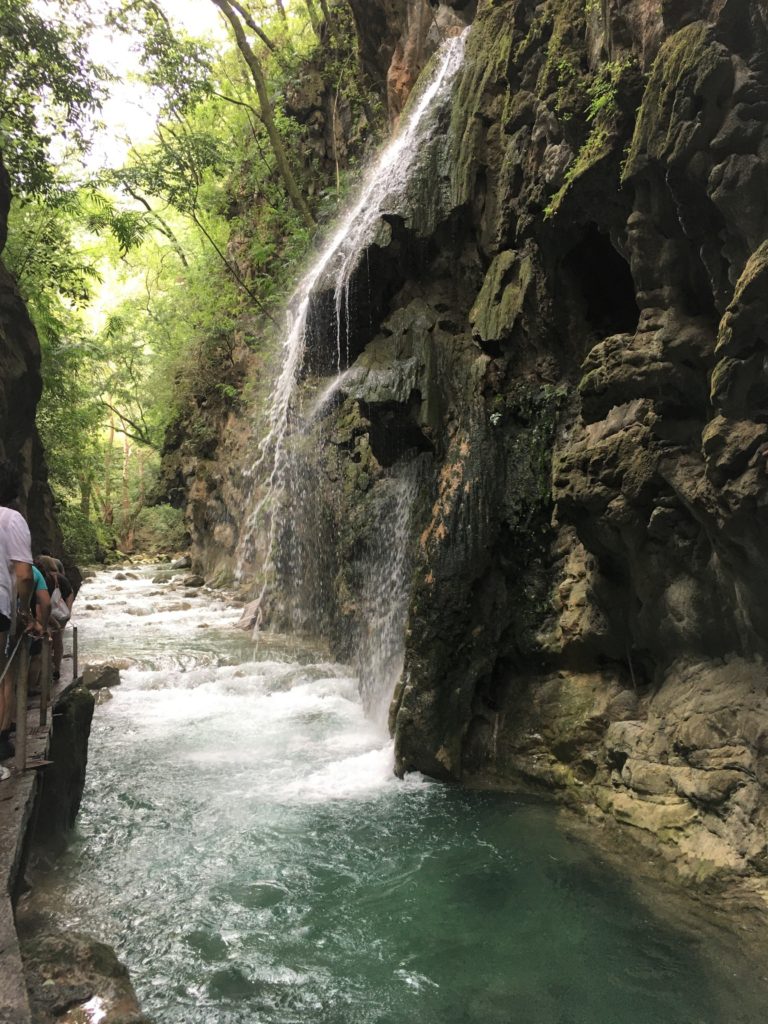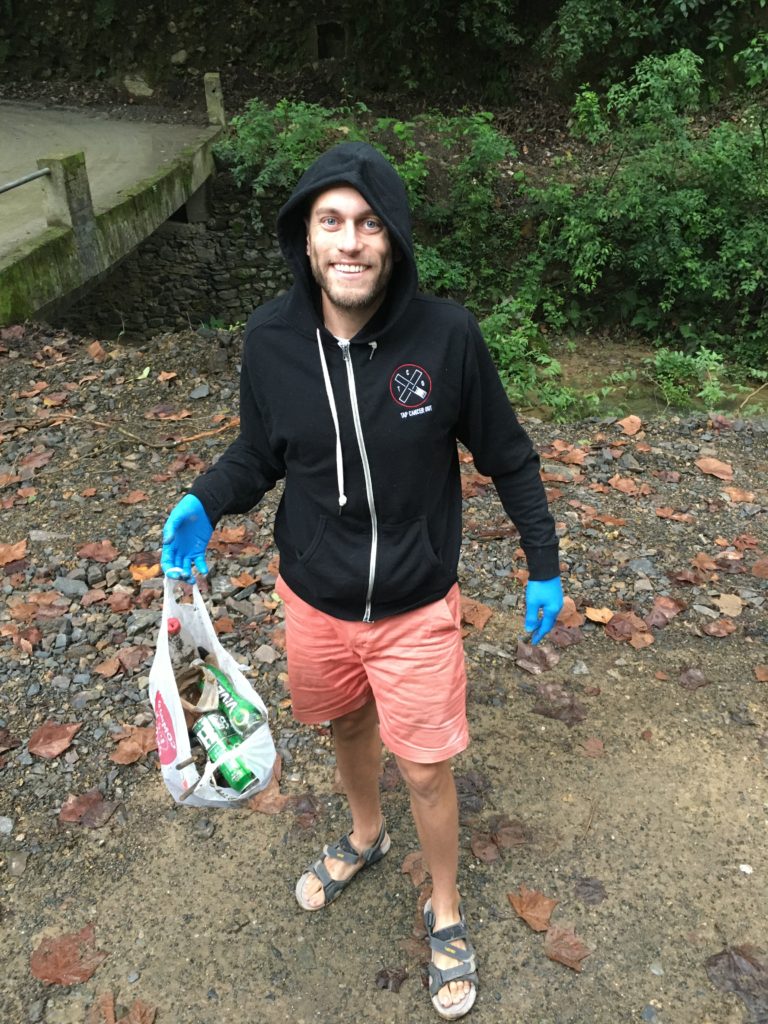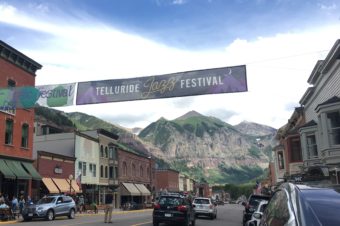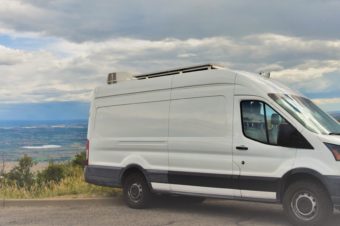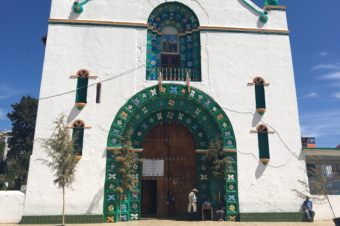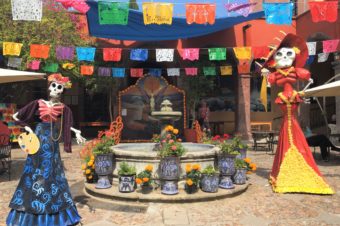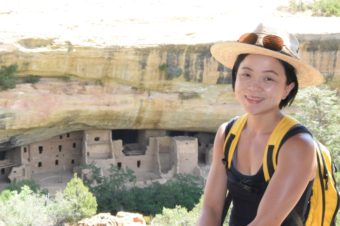Table of Contents
Why VanLife in the Sierra Gorda Biosphere Reserve, Mexico?
For most people, a vacation to Mexico conjures images of either 1) a long, sandy beach sipping piña colada, or 2) large, bustling cities with the remains of colonial architecture. Dare to be different! Explore a place that is still under the radar, despite its countless treasures and water-filled adventures.
The Sierra Gorda Biosphere Reserve is a fantastic way to “mix it up” on your trip.
When I was planning our vanlife adventure, instead of routing us from one colonial city (Zacatecas) directly to another larger colonial city (San Miguel de Allende), I decided to take a two-week detour through the Sierra Gorda Biosphere Reserve to mix it up.
Two reasons why this is a great idea:
- When you’re visiting two (apparently) similar places, back to back, (let’s say, San Diego vs. Los Angeles) your mind will naturally and perhaps unwittingly make comparisons. Chances are, one will form in your mind to be better or worse than the other. To avoid judging one place based on your experience of another, you can insert something entirely different in between – such as a lovely nature escape through the Sierra Gorda mountains!
- You are less likely to tire of sightseeing repetition. As an avid traveler, I recognize that sometimes a cathedral here feels like a cathedral there. Or, I’ve felt “museum-ed out” after going to so many in a row. So, why not give yourself a break by leaving cathedrals and museums altogether? This route is anything but repetitive.
The Sierra Gorda Biosphere Reserve preserves an amazing ecosystem.
The Sierra Gorda Biosphere Reserve is a natural protected area that covers a third of Querétaro state. The area is valued for its wide diversity of plant and animal life, due to multiple microenvironments caused by variations in altitude, rainfall, sunlight, and temperature. The Ecological Group of Sierra Gorda has all of the latest statistics on why Sierra Gorda is the most diverse protected ecosystem in the country. Now that’s something to get behind!
This route through the Sierra Gorda Biosphere Reserve offers a different experience at every stop.
It’s amazing how much we’re drawn to water. Have you ever considered how many outdoor activities revolve around us wanting to see or touch or play in water? Well, on this route, water takes the main stage – in different forms, different colors, different environments. Join the adventure and appreciate the variety!
Where to Park Overnight in the Sierra Gorda Biosphere Reserve, Mexico
Choosing where to park is among the most important decisions in vanlife. You want it to be safe, quiet(ish), allowed, and cost-efficient. In the route that I outline below, for each stop on the trip, I will include the parking and van-boondocking situation that we came across.
If you’re unsure whether you can stay, you can ask “Puedo pasar la noche aquí?”
Working in Sierra Gorda Biosphere Reserve, Mexico
If you need to work, there are a few towns along this particular route where you can find internet and a comfortable workplace. The largest is Jalpan de Serra, and the second largest is Pinal de Amoles.
While we had connectivity at Laguna de la Media Luna and in the towns, we had no service in the areas that we boondocked. It’s a great time to unpack those books or to do some writing!
Our Route through the Sierra Gorda Biosphere Reserve, Mexico
An Overview of the Route
I confess: This route is a bit of a misnomer, because it covers slightly more than the Sierra Gorda mountains.
The route begins in Rioverde, of San Luis Potosí state, which is not officially part of the Sierra Gorda. The route then goes south on highway 69 and west on highway 120, for a total of five stops that include a lake, a stop along the river, a small town, and two waterfalls.
Please note that we did our journey in mid- to late-October. This is a rainy time for this area, and it’s slightly off-season. We spent a leisurely two weeks from start to finish, though we also fit in a few days of van repair and computer work.
First Stop: Laguna de la Media Luna
Laguna de la Media Luna is a beautiful preserved lagoon that was declared a protected natural area by the San Luis Potosí state government back in 2003. It is literally translated as the lagoon of the half-moon, because of its crescent-like shape.
This place is amazing! It showcases a diverse, natural environment, offers an opportunity to swim, snorkel, or scuba dive in the clearest, most temperate waters I’ve ever experienced, and holds fascinating archaeological and cultural significance.
The lagoon houses underwater plants unique to this ecosystem, petrified animal remains, and pre-Hispanic archaeological artifacts that remain embedded deep in the lagoon floor. You can scuba dive to see all of this, for only $850 MXN, or about $43 USD. It is an excellent learning environment for beginner scuba divers.
There are two general areas to swim – in the crystal clear, shallow river that meanders throughout the park, or in the equally clear, much deeper lake at the far end of the park. Both are exceptionally lovely, and different, so take your time to enjoy both!
The unique underwater scenery of submerged lily pad-like plants, lit by the sun’s bright white-yellow rays in the peaceful, crystal clear water, will remain one of my favorite images of our adventure in Mexico.
Laguna de la Media Luna also has everything you need for a relaxing vacation – supplies, snacks, souvenirs, toilets, showers, scuba gear, equipment rentals, prepared food stalls, picnic tables, overnight camping areas, for-rent cabanas, and even a museum! Prices for everything are extremely affordable. You can also bring your own food and gear into the park – there are wheelbarrows all over the parking lot for your use. Tent camping is available for free, and cabanas for rent, although no dogs are allowed.
- Tickets: $40 MXN for adults, $20 MXN for children and seniors.
- Hours: The lake is open daily from 7 am to 7 pm.
- Getting Here: From San Luis Potosí, Google mapped us up the 57 and back down the 69, instead of taking the 49 directly east. From Rioverde, the paved road eventually becomes a very bumpy dirt road. A 4X4 is not necessary, however, we’re certainly very glad that we did various suspension modifications and upgrades to our 2015 Ford Transit 250 van in preparation for drives like this.
- Parking/Boondocking: The lake has a massive dirt parking lot, testament to how busy this place can get during high season. Parking is free, and management permits people to overnight in their vehicles. We felt very safe and secured here.
- Bathroom/Shower Fees: $5 MXN each use. Expect cold showers.
- Other costs: I rented a chaleco (life vest) for $30 MXN a day. Bring an ID to leave as a deposit.
- If you have dogs: Dogs are limited to the sizeable parking lot. Just beware, for both yourself and your dog, of a certain tree (by the stone walking path in the parking lot) that has very thorny branches. I punctured my heel with one of these thorns and it was swollen for days. Willie got a couple stuck in his paws.
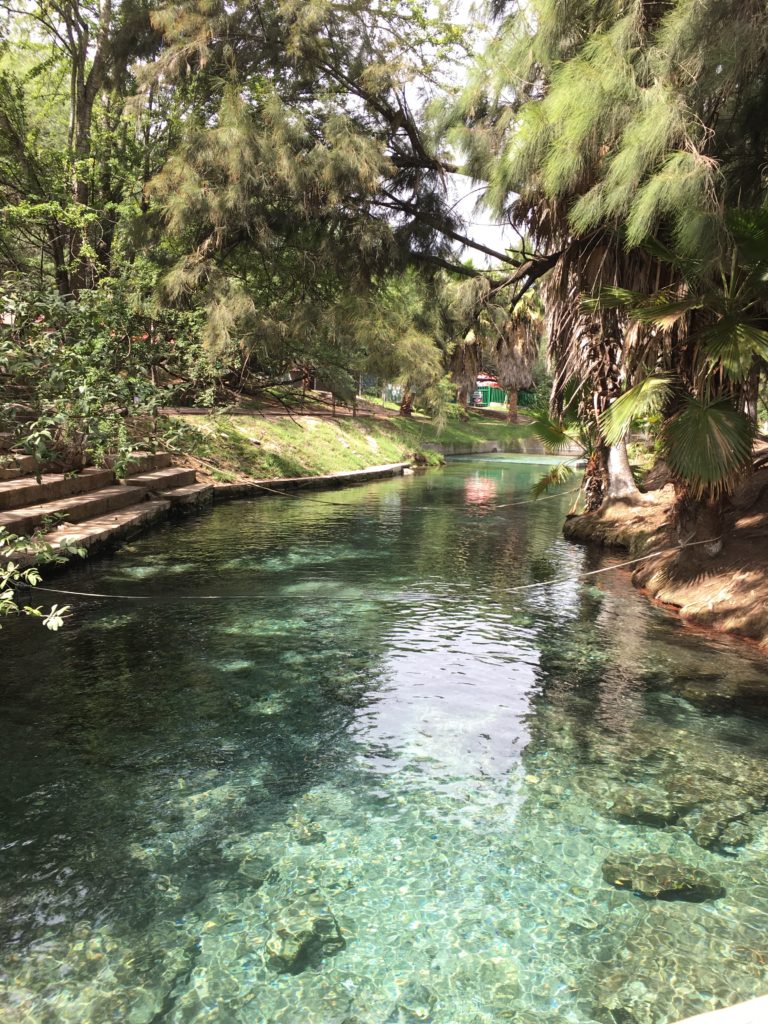
Pitstop: Rioverde Mercado Principal
If you need to replenish your supplies, the Rioverde Mercado Colón is the place to be. We happened to be there on a Saturday, when the market is its busiest. We had much fun wandering through the market, buying fresh vegetables, dried chilies, butter, honey, chicharrones, barbacoa and lots of sweet treats.
- Orientation: The first thing you’ll see is the town’s beautiful cathedral tower and square. Across from the square is a large grassy park, with signature bright letters spelling “RIOVERDE.” Next to the cathedral is the market, with stalls selling everything from shoes and jewelry to produce to fully cooked meals.
- Parking: It’s easier to find street parking and walk the distance back to the market. You may be able to find an estacionamiento (parking lot), but if you’ve got a high roof, extended vehicle like our van, height clearance and narrow driveways might be a challenge.
Second Stop: Juntas del Concá
Juntas del Concá is where the river meets highway 69. The camping area is under the bridge. Pull over to the right, just before the bridge, and you’ll see painted “Entrada” letters pointing down a concrete driveway.
It must have been the timing of our visit in mid-October, but the river was way less charming than I expected. Pictures on GoogleMap show a river with clear, azure waters. Our experience was a muddy river with murky, brownish-gray waters. It must have been the result of heavy rains at this time of year.
That didn’t stop us from spending three nights boondocking here, however. Every night there was lots of rain, lightning and thunder. Our extra-large canopy went flying one night, flipping upside down in the intense wind. It’s times like these that make us grateful for a roof vent with a rain hood, because even though it was raining, it was still very humid and we needed to air out the condensation.
- Entrance: Parking fee is $50 MXN; Camping Fee is $40 MXN. When we explained that we’re a “casa rodante” (rolling home), and that we wouldn’t need to rent a room, she charged us $90 MXN.
- Getting Here: From Rioverde, take the 69 southbound. This is a two-lane “libre” (public) highway that takes you deep into the Sierra Gorda Biosphere Reserve. The road is of good condition, but keep an eye out for the many topes (speedbumps), since you’re driving through local communities. The scenery is beautiful – a keen eye will notice slight changes in the flora throughout the drive.
- Showers & Bathroom: Available right next to the parking lot. Showers are up the ramp, behind the bathrooms. $5 MXN if an attendant is there.
- If you have dogs: There’s signage that dogs are not allowed in the river, but none of the locals obey that. There are also many stray dogs here, but they are well-behaved, just looking for some affection and food. Jon likes to feed and befriend stray dogs so that we have some canine protection, or at least an alarm while boondocking. It’s fun to have a temporarily adopted pack, although quite heart-breaking when you have to leave the pack behind
Third Stop: Jalpan de Serra
Jalpan de Serra is a UNESCO World Cultural Heritage Site, a Pueblo Mágico, and the largest town you’ll find on this route. The town sprawls through 4km (2.5 miles) of the highway, with everything you could need – grocery stores, restaurants, gas, a Cathedral, laundry, and a tourist center. We stayed in and around the town center for two nights, fitting in some work time after about a week of no connectivity.
The town’s star attraction is its Franciscan mission, the Mission of the Apostle Santiago. This Mission is the oldest among five Franciscan missions that were named UNESCO World Heritage sites in 2003. All five Franciscan missions were founded by Father Junípero Serra as part of his evangelization of the Sierra Gorda. My favorite feature is the mission bells: at the top of every hour, the mission bells ring out a lovely song, a different tune for every hour.
The town market is a bustling place to do your grocery shopping. You could also pick up souvenirs, get your shoes shined, and even play some arcade games. Several vendors speak English.
- Getting Here: From Juntas del Concá, continue on the highway for 40 minutes.
- Where to overnight: We spent our first night on a residential street and our second night on a commercial street next to the town cathedral. We were undisturbed both nights. Street parking in and around the commercial plaza is restricted to 1 hour only, from 8 am to 3:30 pm; unrestricted at all other times. We bought a small container of fruit gazpacho from the business we boondocked in front of, as a gesture of goodwill.
- Connectivity: Cell signal is strong here (we have T-Mobile), even sufficient for hours of internet hotspot. Unfortunately, we couldn’t find a great situation for wi-fi. One café (Kawa Bistro) had decent wireless, but all of its electrical plugs were the old-style two-prong plug, which didn’t work for our laptop chargers. One café (Pao’s Cafeteria) was lovely and had three-prong electrical plugs, but no internet. Other internet cafes we either couldn’t find, weren’t open when they said they would be, or only allowed internet use on their desktop PCs. So, we ended up sitting at a café (Pao’s Cafeteria) using our hotspots.
- Get used to: Businesses not being open. It’s the typical small-town effect; sometimes GoogleMaps isn’t correct, it’s a seasonal difference, or there’s just a note taped to the front door.
Fourth Stop: Cascada de Chuvejes
What I love about this route is that the stops are so different from each other. First, we saw the beautifully clear and peaceful Laguna de la Media Luna. Then, we boondocked beside the river with our pack of stray dog friends. Then, we wandered the quiet little town of Jalpan de Serra. Moving on to Cascada de Chuvejes, with only a vague idea of boondocking possibilities, I didn’t know what to expect.
Wow, was it worth it! The drive from Jalpan de Serra was so beautiful, I couldn’t put my phone down. Even while Jon was pensively focused on the road and its tight turns, I kept “ooh”-ing and “ahh”-ing about the lush green mountains.
I’ve seen many waterfalls in my day, but I must say this one was especially magical. You get much more than a waterfall – you get to explore a wet, mossy forest, a spacious clearing of tall, pale yellow trees, a series of cascading aquamarine pools, and a beautiful 40-meter tall waterfall at the end. The entire trail is as if from a fairy-tale!
Standing at the base of the waterfall, looking upward at the immense spray, Jon looked at me and said, “I think this is my favorite moment of our sabbatical.” And I could understand why he said that. At Cascada de Chuvejes, some of the water from above crashes first onto a jutting chunk of rock about 20 feet in the air, which causes an impressively forceful, nearly horizontal spray that then gracefully dances downward into the lake below, as if in slow motion. The sight is mesmerizing, peaceful and powerful at the same time.
The path to the waterfall is short, but very muddy, slippery and rocky. Wear appropriate shoes, and you may want something rainproof as well.
- Entrance: $40 MXN adults, $10 MXN for children.
- Getting Here: From Jalpan de Serra, take highway XX west. It is an absolutely lovely, tree-lined drive. There are signs marking the left turn toward the waterfall. Take this road for about 20 minutes. The dirt road is compact and well-used enough that, despite the rains of the last week, we didn’t need 4-wheel drive. There’s a section of the road that is steep, but that section has been paved in concrete for safety.
- Parking: There’s parking available right outside of the entrance to the waterfall.
- Boondocking: While there are a couple campgrounds advertising restrooms and showers, we bypassed them for a boondocking spot much closer to the waterfall. We found the perfect solution, right beside the river, directly below the entrance to the waterfall.
- Showers & Bathroom: Available just after the ticket office.
- If you have dogs: There are many stray dogs here. Some may even accompany you along your trail. Dogs are allowed to the waterfall, on leash. There are trash bags along the trail for your deposits. Our dog Willie was a cold, muddy mess by the end. We washed him off with water by the bathrooms before wrapping him in a towel and carrying him back to the van.
Fifth Stop: Puente de Dios
İAy, Dios! Literally translated as the Point of God, Puente de Dios was certainly the hardest stop to reach. While we made it just fine in our 9,000+ pound, front-wheel drive monolith of a van, it was our bumpiest and muddiest ride to date. It’s a one-lane road, so you’ll get your fair share of tight squeezes. Luckily, Mexican drivers are very skilled at this. When in doubt, pull to the side and let them do their thing.
After we parked, Marcelo, the owner of the hotel, came down to say hello. He asked to look inside our van and was quite impressed that we built it all ourselves.
Onward into Puente de Dios! We had a surprise change to our plans: because of the rains at this time of year, we couldn’t actually reach the Puente de Dios waterfall. They had everyone double back after the canyon, because crossing the river was too dangerous with the strong current. So, unfortunately, I can’t tell you anything about the waterfall itself.
I can, however, tell you about the river crossing and the canyon. Expect to get wet. We had to wade through the river three times each direction, with the last crossing being the wettest. The water reached my mid-thighs at the deepest point. It was a fun experience, in the way that wading across fast-moving water always adds a little extra challenge and adventure. It’s especially fun when that water is super cold and the current is strong enough to trip the overconfident or underprepared. When it’s busy, you’re surrounded by many who may just be the next victim – which, of course, makes it even more fun!
After crossing the river, you climb up a wooden ladder to walk along the far wall of the canyon. The river, throughout, is clear, glass-blue, clean, and cold. We visited in October; the water level will be different depending on the time of year. Bring appropriate shoes and clothing. Unlike us (pictured).
- Entrance: $75 MXN per person. Entrance includes your own ‘tour guide’ to lead you on the hike.
- Getting Here: From Cascada de Chuvejas, continue on the same highway. It’s a short drive before you have to turn right to head down the long road toward the waterfall. This road is bumpy and can get muddy. Despite the rain and mud, our van made it fine. Our brakes got a little hot though, so keep a nose out for that.
- Parking/Boondocking: We turned into the first “estacionamiento” sign we found, right next to the Puente de Dios Hotel. A young boy helped us park, and charged us $80 MXN for the night. We were just 20 feet from the river, and there was a post with two 20-amp plugs. We didn’t connect the van to it, but I did use it to boil water in my electric kettle.
- Bathroom: Free with parking at the hotel; $5 MXN otherwise.
- Showers: Available at the hotel for $25 MXN (even though the sign says it’s included in parking, the woman at the showers insisted that wasn’t the case). The shower water comes directly from the river, so it’s super cold.
- If you have dogs: There are many stray dogs here. Dogs are allowed into Puente de Dios, but we’re glad we left Willie in the van. It would have been complicated with the super cold river crossing, the strong current, and the ladder, not to mention all the mud!
Back to the City: The Drive to Querétaro
From Puente de Dios to Querétaro, the drive is an event in its own right. It is absolutely gorgeous.
Remember when I mentioned the microenvironments caused by variations in altitude, rainfall, sunlight, and temperature? Well, you can really notice the difference in micro-climates during this curvy drive up and down and all around the mountains.
The drive goes through tropical jungle foliage to cool, cloudy pine forests to dry, cacti-filled desert valleys in just a couple hours. There are many spots to pull over for expansive views. It feels like driving from Hawaii’s volcanoes to California’s Sierra Nevada mountains to Arizona’s flat plains.
If you’d like to visit another Pueblo Mágico on your trip, Piñal de Amoles and Bernal are both excellent candidates. They are both well-accustomed to tourism, and have their own famed specialties, so you’ll be able to find just about anything you need.
Best Tips for the Sierra Gorda Biosphere Reserve, Mexico
Everyone travels differently. Preferences of comfort, security, food, adventure, and pace vary, so I cannot presume to tell you how to travel. I hope you will take all recommendations with a grain of salt and leave your mind open for things that I could not tell you.
Matters of Comfort
This journey will take you through many different physical environments. What you experience will depend greatly on what time of year you go.
As for our own experience in rainy mid-October, I can tell you that for some days of our trip, we used our external A/C unit, powered by our gas generator, and stayed in our underwear all day. It was sticky and hot on those days. I can also tell you that for other days of our trip, I bust out my fleece jacket, my rain jacket, and my hiking boots. It was cold and foggy those days. I’m telling you: it is so diverse here!
Bring layers. Bring refillable jugs so you don’t run out and you have the option to boondock longer if you want to. Bring an umbrella or a rain jacket. Bring sunscreen, a hat, and sunglasses. Bring reading material, beach toys, and camping/picnicking gear. Bring small bills and coins to make it easy for the vendors.
Matters of Your Vehicle
Our 2015 Ford Transit high roof extended cab van survived the journey! Below is a list of features that we believe helped make the journey smooth(er).
To be clear, I’m not saying that everything in the list below is a necessity; I only include this list so that you know what resources and capabilities we built into our van:
- Installed an external 13,500 BTU A/C unit, and got a gas generator to run it (since our solar setup isn’t sufficient to run for more than 45 minutes).
- Installed all-terrain tires that match the load index determined by the factory.
- Installed 500 watts of solar panels with three 200-amp hour (gross) AGM batteries.
- Suspension modifications, like airbags in the back, front coil spring inserts, and upgraded shocks for the front and back.
- We have a portable toilet that we can dump into any toilet (no RV plug-in or hook-up needed). Same with our grey water tank.
- We can carry 28 gallons of water at any time.
The one adjustment to the van that Jon wished he had done was to upgrade the brakes. While we replaced the brakes, we didn’t upgrade to a higher heat threshold to accommodate for the additional weight that our van build added to the van.
Matters of Social Responsibility
As a DIY, budget-conscious, vanlife traveler, I fully recognize that we do not contribute to the local tourism economy as much as does the more traditional traveler. The traditional traveler I’m referring to probably rents a hotel room, takes a bus or commissions a driver, signs up for tours, buys a lot of souvenirs, and eats out three meals a day.
On one hand, I recognize that the tourist trade is a source of income for many people in these kinds of communities. On the other hand, it is only by traveling in this manner that we can afford to visit, access less-traveled places, and stay for a longer time. I’m sure this is true for many would-be travelers, to whom costs or lack of information (or even translation) has been an impediment.
So, here’s where I see my contribution, and where I hope you will choose to contribute as well:
- Buy what you need here. I am not a proponent of buying for the sake of buying, especially when you live in a limited-space vehicle, but if there’s something you need, these communities could benefit from your dollar.
- Pack it in, pack it out. In the Sierra Gorda, the issue of garbage management is a prevalent problem. The local communities do their best to collect and properly dispose of garbage, but it is most helpful to them if we as tourists pack out our garbage. I don’t mean depositing our trash in a trash can either; I mean actually packing it out with us down the mountain.
- Leave the boondocking spot better than you found it. When we boondocked, we picked up trash in the surrounding areas. Pack some gloves or a trash picker and some trash bags. Remember to leave some space for the trash.
- Share your experience! The more you share your experience, the easier it is for others to get the information they need. Understandably, one of the biggest barriers for people is a lack of information.
Buen viaje a Sierra Gorda!
If you have any questions or comments, feel free to contact us at hello@DangGoodLife.com.
If this article has helped you to plan your own adventure through the Sierra Gorda Biosphere Reserve, please consider supporting us by shopping through our affiliate links, sharing this post, and engaging with us on our social media channels. Your support helps us keep gas in the van so that we can continue to provide this Dang Good content.
With sincere gratitude,
Lien & Jon
